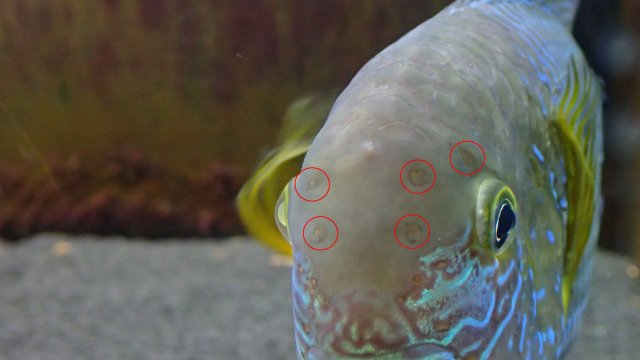I know we are using the terms hexamita, spironucleus, HITH, etc..interchangeably, but there could be a difference in the type of infestation, particular parasite at play. I know a lot of studies are on spironucleus vortens but the case is not always the same.
Members of the genus Spironucleus are flagellated anaerobic protozoa that parasitize marine and fresh water fish as well as terrestrial vertebrates including mice and turkeys.9,19,25,26,31 Together with other flagellates including Giardia, Hexamita, Enteromonas, and Trichomonas, they comprise a clade known as Fornicata. These organisms are classified as either enteromonads, containing one karyomastigont (nucleus and cytopharynx), or diplomonads with two karyomastigonts. Fornicata are unusual among eukaryotes in that they lack mitochondria, a Golgi apparatus, and cytochromes. Interestingly, some genera are capable of amino acid fermentation for energy production, a trait more commonly found in bacteria than in protozoa.1,2 These characteristics suggest that Fornicata are amongst the earliest and most primitive offshoots in the eukaryotic tree.10
Spironucleus spp. are diplomonads but recently developed molecular phylogenies reveal that reduplication of the karyomastigont has occurred multiple times throughout evolutionary history and that the genus Spironucleus is actually a paraphyletic clade.15 Based on small subunit ribosomal DNA (SSU rDNA) sequencing, Spironucleus species cluster into three separate groups, the first containing parasites of saltwater fish, the second, parasites of freshwater fish, and the third, parasites of terrestrial animals.15
Spironucleus and closely related Hexamita spp., infect a variety of vertebrate hosts, including birds, fishes, mice, and nonhuman primates.
Members of the genus Spironucleus are flagellated anaerobic protozoa that parasitize marine and fresh water fish as well as terrestrial vertebrates including mice and turkeys.9,19,25,26,31 Together with other flagellates including Giardia, Hexamita, Enteromonas, and Trichomonas, they comprise a clade known as Fornicata. These organisms are classified as either enteromonads, containing one karyomastigont (nucleus and cytopharynx), or diplomonads with two karyomastigonts. Fornicata are unusual among eukaryotes in that they lack mitochondria, a Golgi apparatus, and cytochromes. Interestingly, some genera are capable of amino acid fermentation for energy production, a trait more commonly found in bacteria than in protozoa.1,2 These characteristics suggest that Fornicata are amongst the earliest and most primitive offshoots in the eukaryotic tree.10
Spironucleus spp. are diplomonads but recently developed molecular phylogenies reveal that reduplication of the karyomastigont has occurred multiple times throughout evolutionary history and that the genus Spironucleus is actually a paraphyletic clade.15 Based on small subunit ribosomal DNA (SSU rDNA) sequencing, Spironucleus species cluster into three separate groups, the first containing parasites of saltwater fish, the second, parasites of freshwater fish, and the third, parasites of terrestrial animals.15
Spironucleus and closely related Hexamita spp., infect a variety of vertebrate hosts, including birds, fishes, mice, and nonhuman primates.



